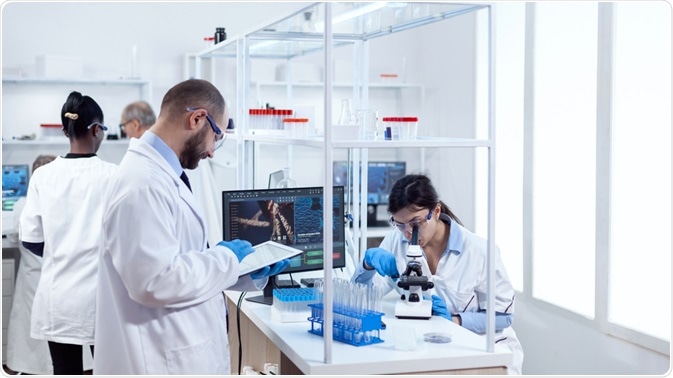What is in Silico?
Over the last century, scientific research in the field of pharmacology has evolved greatly. Thanks to carefully designed studies and continuous advancements in the technology available to measure and analyze biological samples and subjects, our knowledge of biological systems continues to grow.

Image Credit: DC Studio/Shutterstock.com
Over the years, scientists have been able to establish qualitative and semi-quantitative relations between brain activity and the molecular structure of neural tissues. To date, in vitro, and in vivo models have produced the vast majority of data in this area. However, these methods are not without their limitations.
In vivo models present risk to those recruited for the study, or rely on animal models where findings may not apply to humans. In vitro models do not account for the complex interactions that occur in vivo and how these interactions may influence the hypothesis being studied.
In recent years in silico models have become increasingly popular. The term ‘in silico’ refers to computational models that investigate pharmacological hypotheses using methods such as databases, data analysis tools, data mining, homology models, machine learning, pharmacophores, quantitative structure-activity relationships, and network analysis tools. Usually, in silico methods are used alongside in vitro models.
The use of such models is growing in popularity, and already they have been successful in achieving numerous advancements in a range of pharmacological areas such as the clarification of absorption, distribution, metabolism, excretion and toxicity properties, the discovery and optimization of novel molecules, and physicochemical characterization.
Here, we discuss the development of in silico methods and cover the most commonly used techniques.
The development of in silico techniques in pharmacology
The term ‘in silico’ has not been around in the scientific community for many years. It is a relatively new term used to describe an emerging area of study. In silico originally meant “performed on computer or via computer simulation”, in modern science it refers to experimental techniques performed by computers and is related to the more established terms of in vivo and in vitro studies.
The origin of the use of the term in the field of pharmacology is unclear. It seems it first appeared in public in 1989 when it was used in the “Cellular Automata: Theory and Applications” workshop held in New Mexico. It was used by mathematician Pedro Miramontes, from the National Autonomous University of Mexico (UNAM), who categorized the biological experiments conducted purely via a computer with the term “in silico”. Other early uses of the term appear in early 1990s publications including Sieburg (1990) and Danchin (1991).
While in silico studies are a relatively new method of investigating hypotheses, the number of research projects that have begun to rely on these methods is rapidly growing. Often, they are being used to explore how novel therapeutics interact with certain molecules in the body, biological tissues, and pathogens. These studies have already produced findings that have made waves in the medical sector.
For example, in silico methods (software emulations) were used in a 2009 study that predicted how certain already-approved drugs could be used to treat numerous drug-resistant strains of tuberculosis. Using conventional methods, such an investigation would have taken considerable more time and resources.
A range of in silico techniques exist and are currently being used. Here, we present perhaps the most widely used methods.
Bacterial sequencing techniques represent a group of in silico methods that are used to identify bacteria. These techniques sequence bacterial DNA and RNA. Polymerase chain reaction (PCR) is the most commonly used technique, a method that has become more widely known due to its use in testing for COVID-19. PCR works by duplicating a single or several pieces of DNA, creating millions of copies of the sequence. As a result, it is a highly sensitive method of detecting bacteria and viruses that underlie serious diseases.
Another popular in silico method of molecular modeling, a technique capable of showing how therapeutic molecules interact with the nuclear receptors of cells. One molecular modeling study of particular note is that of Trevor Marshall, who used computer-based emulations to reveal that a particular metabolite of vitamin D, 25-D, along with a substance generated by bacteria, Capnine, is able to turn off the vitamin D receptor.
Finally, scientists have built a computer model that allows for whole-cell simulations. These studies replicate the interior of target cells to demonstrate how molecules interact with them. These whole-cell simulation studies give information at the level of the cell and can accurately simulate the behavior of living cells.
While there are other in silico techniques, these are perhaps the most common. These techniques will likely continue to be used in pharmacology to produce significant data capable of advancing our knowledge of biology.
References:
- Ekins, S., Mestres, J. and Testa, B., 2007. In silico pharmacology for drug discovery: methods for virtual ligand screening and profiling. British Journal of Pharmacology, 152(1), pp.9-20. https://www.ncbi.nlm.nih.gov/pmc/articles/PMC1978274/
- Kinnings, S., Liu, N., Buchmeier, N., Tonge, P., Xie, L. and Bourne, P., 2009. Drug Discovery Using Chemical Systems Biology: Repositioning the Safe Medicine Comtan to Treat Multi-Drug and Extensively Drug-Resistant Tuberculosis. PLoS Computational Biology, 5(7), p.e1000423. https://journals.plos.org/ploscompbiol/article?id=10.1371/journal.pcbi.1000423#equal-contrib
- Roberts, E., Magis, A., Ortiz, J., Baumeister, W. and Luthey-Schulten, Z., 2011. Noise Contributions in an Inducible Genetic Switch: A Whole-Cell Simulation Study. PLoS Computational Biology, 7(3), p.e1002010. https://pubmed.ncbi.nlm.nih.gov/21423716/
Further Reading
- All Pharmacology Content
- Pharmacology
- What is Drug Absorption?
- Drug Distribution
- Drug Excretion / Elimination
Last Updated: Oct 27, 2021

Written by
Sarah Moore
After studying Psychology and then Neuroscience, Sarah quickly found her enjoyment for researching and writing research papers; turning to a passion to connect ideas with people through writing.
Source: Read Full Article


